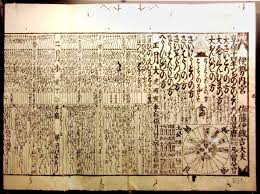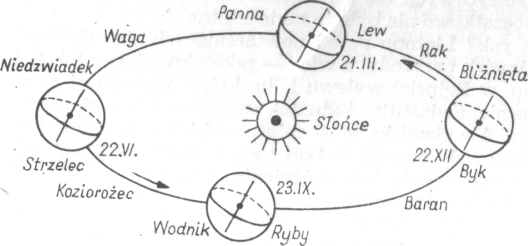Kłopoty z miesiącem i rokiem

Najmniej kłopotu sprawiała doba. Liczono ją od wschodu do wschodu (ewentualnie — od zachodu do zachodu) Słońca. Gorzej było z miesiącem. Liczono go od nowiu do nowiu Księżyca. Ten czas wynosi jednak średnio 29 dni, 12 godzin, 44 minuty i 3 sekundy. A więc jest większy od czterech siedmiodniowych księżycowych faz i nie dzieli się równo na doby. Ale początkowo nie było to takie istotne.
A rok? Liczono go od powtarzających się cyklicznie zjawisk przyrody, a więc — początku wiosny lub (jak np. w Egipcie) wylewu Nilu, który następował regularnie, zwiastując ludności nowy pomyślny okres życia. Ale zjawiska te — zależne od klimatu — nie występowały zawsze w tym samym czasie. Zdarzały się przyspieszenia lub opóźnienia. Liczony według nich rok nie był więc równy.
Ówcześni astronomowie nie wiedzieli co sprawia, że na Ziemi występują pory roku. Nie wiedzieli, że Ziemia obraca się wokół swej osi, powodując dzień i noc i że krąży wokół Słońca, przy czym czas tego obiegu trwa rok, czyli 365 dni, 5 godzin, 48 minut i 46 Sekund. A pory roku wynikają z faktu, że oś obrotu Ziemi nie jest równoległa do osi orbity, czyli toru. po którym Ziemia wędruje wokół Słońca, lecz tworzy z jej kierunkiem kąt około 23,5°. Nie wiedzieli także, że Ziemia nie zatacza wokół Słońca koła (tego nie wiedział nawet Mikołaj Kopernik), lecz krąży po elipsie. co sprawia, że pory roku nie mają tej samej długości. Prędkość ruchu Ziemi w różnych częściach orbity jest różna. W rezultacie:
Wiosna trwa od równonocy wiosennej do przesilenia letniego (21 III—21 VI), tj. 92 dni i 19 godzin.
Lato — od przesilenia letniego do równonocy jesiennej (22 VI—22 IX), tj. 93 dni i 15 godzin.
Jesień — od równonocy jesiennej do przesilenia zimowego (23 IX—21 XII), tj. 89 dni i 19 godzin.
Zima — od przesilenia zimowego do równonocy wiosennej (22 XII—20 III), tj. 89 dni.
Ilustruje to rysunek, przedstawiający ruch Ziemi dokoła Słońca.

Zaznaczono na nim położenie Ziemi na orbicie w dniach 22 XII, 21 III, 22 VI i 23 IX, tj. dniach dzielących orbitę na 4 części. Zaznaczono też położenie osi ziemskiej względem płaszczyzny orbity. Tak przedstawia się prawdziwy ruch Ziemi dokoła Słońca i dokoła własnej osi.
Nie wiedząc o obiegu Ziemi dokoła Słońca, zauważono jednak owe „punkty graniczne”, dzielące rok na 4 pory. Najważniejsze z nich i najłatwiej dostrzegalne były „punkty” równonocy wiosennej i jesiennej. Ustalenie, kiedy one występują, było początkiem dokładnego ustalenia długości (a zarazem i początku) roku, a więc — podstawy rachuby czasu, mniej więcej zgodnej z astronomiczną.
Tak obliczali rok starożytni mieszkańcy Wysp Brytyjskich w II tysiącleciu p.n.e. Dowodem jest kamienny krąg kultowy (jedno z najstarszych obserwatoriów astronomicznych świata), wzniesiony w Stonehenge w południowej Anglii. Umożliwiał on dość dokładne określenie letniego i zimowego przesilenia. Dni te — ustalane i ogłaszane przez kapłanów — święcono uroczyście. Od nich też liczono czas.
W 1955 roku lotnicy peruwiańscy odkryli w Peru — na przestrzeni wielu kilometrów kwadratowych — zarys figur geometrycznych, ptaków w locie i pająków. Figury te, jak ustalono, stanowiły kiedyś sieć kanałów irygacyjnych. Nie byłoby w tym nic nadzwyczajnego, gdyby nie dalsze badania, których wyniki stały się wręcz sensacyjne. Układ poszczególnych znaków i ich kierunki dowodzą, że owe kanały stworzone zostały przez astronomów i to wcale biegłych w swej sztuce. Jedne wskazywały na horyzoncie gdzie wschodzi i zachodzi Słońce w czasie przesilenia dnia z nocą, inne — wyznaczały wschody i zachody Księżyca, planet oraz niektórych gwiazd. Ptaki zaś i pająki symbolizowały konstelacje gwiezdne. A wszystko to, jak ustalili uczeni, powstało około 10 000 lat temu!
Egipcjanie poradzili sobie nieco inaczej. Zainteresowali się mianowicie Syriuszem, czyli gwiazdą Sopdet (zwaną przez Greków Sotisem), znajdującą się w gwiazdozbiorze Wielkiego Psa. W ciągu miesięcy zimowych jest ona widoczna przez prawie całą noc. W połowie maja, w ciągu dnia, znajduje się nad horyzontem, niewidoczna z powodu blasku Słońca, i dopiero po zapadnięciu zmierzchu można ją znów dostrzec tuż nad horyzontem zachodnim. W końcu maja kryje się całkowicie w blasku Słońca i pojawia się dopiero w drugiej połowię lipca przed świtem nad wschodnim horyzontem. Dzień, w którym po dwóch miesiącach niewidoczności można ją znów zobaczyć, Egipcjanie uważali za początek roku astronomicznego.
Ów „heliakalny” (od Helios — Słońce) wschód Syriusza przypadał w Egipcie na 19—21 lipca, w Polsce — w połowie sierpnia. Czas od jednego wschodu do następnego, czyli tzw. „rok sotisowy” (równy gwiazdowemu), różni się wprawdzie od roku zwrotnikowego, który stanowi do dziś podstawę naszej rachuby czasu, o około 20 minut, niemniej przyjęcie go za podstawę kalendarza było ogromnym postępem. Rzecz istotna: ów „heliakalny” wschód Syriusza zbiegał się dokładnie z wylewem Nilu. Nil, od którego wylewów zależało życie i pomyślność Egipcjan, był więc przyczyną tego ważnego odkrycia. A chodziło nie tylko o względy praktyczne. Kapłani chcieli zapowiadać ludowi nadchodzące wielkie święto, związane z wylewem „świętej rzeki” i… nie mylić się!
